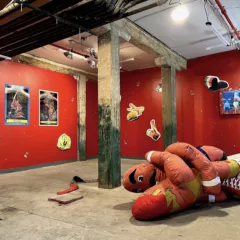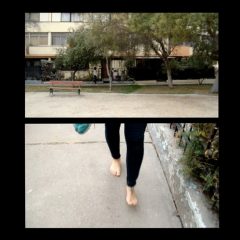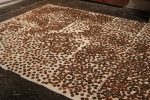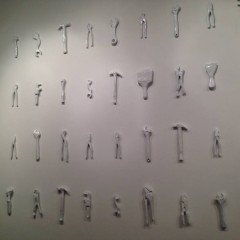July marks the third show for one of Frankford Avenue’s newest creative spaces: Fjord. Named after the tall, rocky crevices on the coasts around Scandinavia, the thin, three-story detached building seems aptly sized to fit snugly into its namesake. It also finds good company in the many DIY art spaces spotting the area aroundFrankford Avenue in Fishtown.
The current exhibit, “Daphne,” is named in homage to curator Liam Holding’s grandmother, and some of the work in the show is quirkily created by Holding using her name – Daphne Gardner – as a sort of alter ego. These artworks created falsely by a real person help to capture the general puckish mood of the show as a whole. Everything is worth a second look and nothing is entirely sincere.
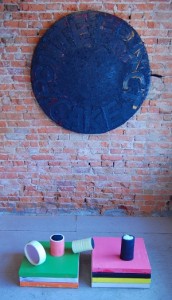
Two works comprise the piece “For your weekends away” by none other than “Daphne Gardner”. Both parts are modeled after licorice candies that Liam Holding’s grandmother from England used to send him. On the wall hangs a reproduction of a black Pontefract Cake and on the floor two piles of canvases and ceramics colored to look like candy. The fact of the matter is, not only were these artworks made by someone other than who they claim, but the paints and glazes would also be potentially toxic, not sugary and delightful.
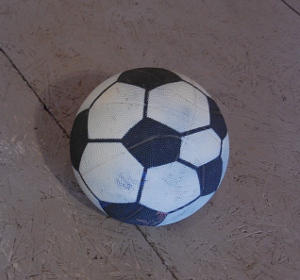
Somewhat more delightful are the works by Rubens Ghenov. One of his objects, along with Ted Gahl’s “Never Forget,” is among the clearer visual gags on display. In the middle of the floor sits a basketball painted to look like a soccer ball. Its face value is purely amusing and its appearance is only skin (or paint) deep. Ghenov’s “Bwarki” is the backboard to a basketball net, minus the net. It is in line with his other sports-related work, but here the center is painted to look like a milk crate – a cheap alternative to a real net. The only video in the show is also by Ghenov, in which he lip syncs and plays a guitar without strings along with the song “Tatugem.”
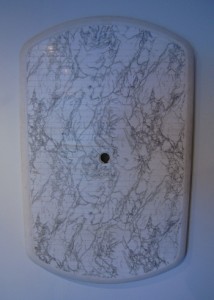
Ted Gahl has one individual image in the show: a blue canvas with a pair of still-wrapped condoms screwed to its lower left corner. The title “Never Forget” is presumably the child or contagion you’ll most likely be stuck with after using these faulty rubbers. The use of a screw is also a great pun for “screwing” as well as for being “screwed.” Its antithesis is the found object “Glory” which is literally just the base to a picnic table for holding an umbrella. The name of course implies a “glory hole,” and it is otherwise flat aside from the umbrella slot. The piece is courtesy of the private collection of Sarah Pater (whose yard it was appropriated from) and its purpose, like a Duchamp piece, is turned upside down. What becomes particularly interesting is the marble pattern on its surface – one which was surely intentional and yet generally takes the back seat to its function.
Rounding out the jests, Matt K. Brett has constructed a to-scale mailbox out of plywood. Its blue color comes from the top pieces of a plywood stack, not paint applied by the artist. The faux mailbox might also serve well as a foil for a candid video if it were placed on the street for passersby to interact with.
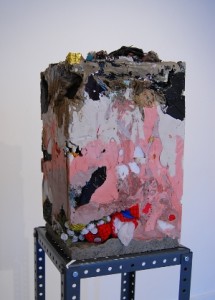
The work of the other three artists in the show is less gag-like, which helps the show ground itself just a bit. Jack Henry includes a couple of “Core Samples” in which he piles junk, trinkets and plaster into tall, rectangular molds to create bizarre urban sedimentary rocks. A painting of a mountain by Cameron Masters has a neon reverse side which acts to backlight the piece a little. It hangs directly across from a window through which there is a “mountain” of renovation detritus mimicking its peak. Last, and certainly not least, is “Pyramid of Skulls” by Jason Huff. Three skull forms arranged into a triangle poke through the glossy surface of a framed painting, staring blankly back at the viewer. They appear curious (if dead) and seem almost mocking in their eyeless gaze.
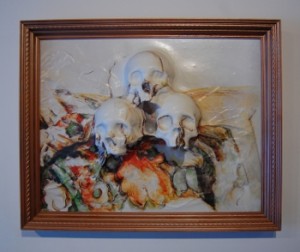
When the show “Daphne” is serious, it reminds us of mortality and waste… but mostly it is anything but serious. In fact, its layers of meta-ness, found objects, and visual puns make for a review chock full of quotation marks, parentheses, and double thinking. Check out Fjord yourself to avoid any confusion from these written explanations. “Daphne” can provide plenty of confounding ideas and paradoxes all on its own, without any assistance. The show is up to July 31.


